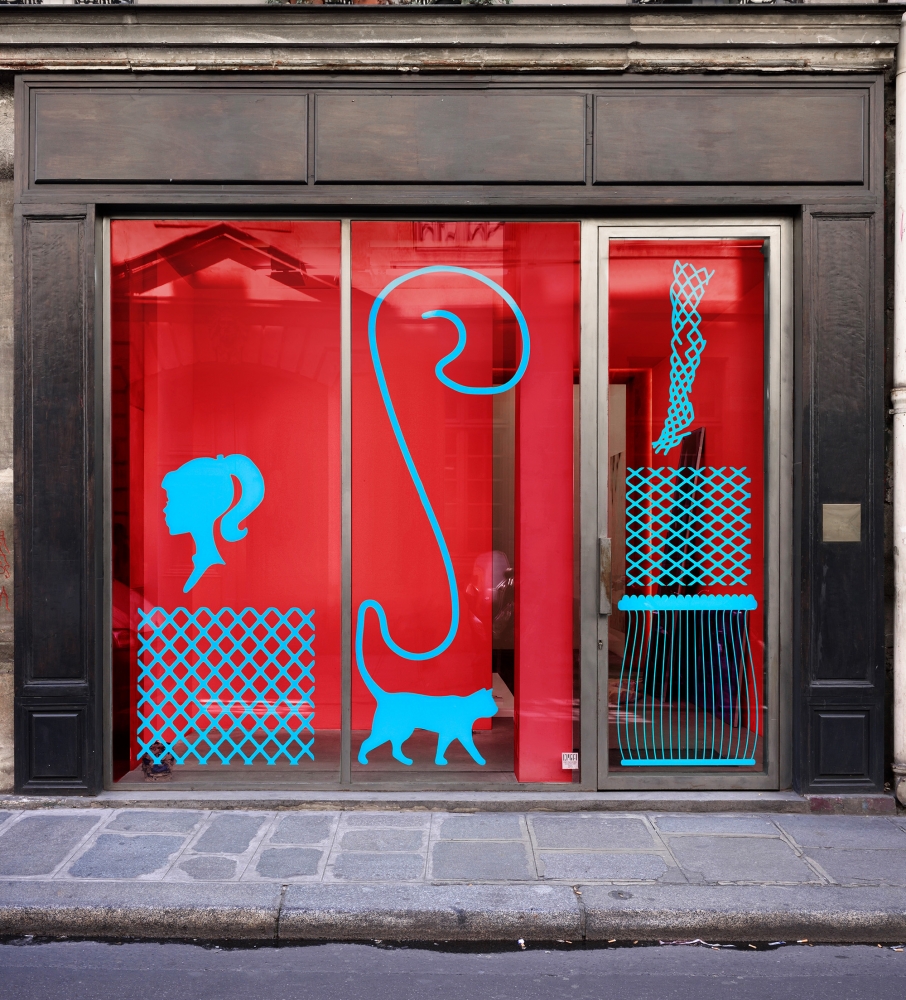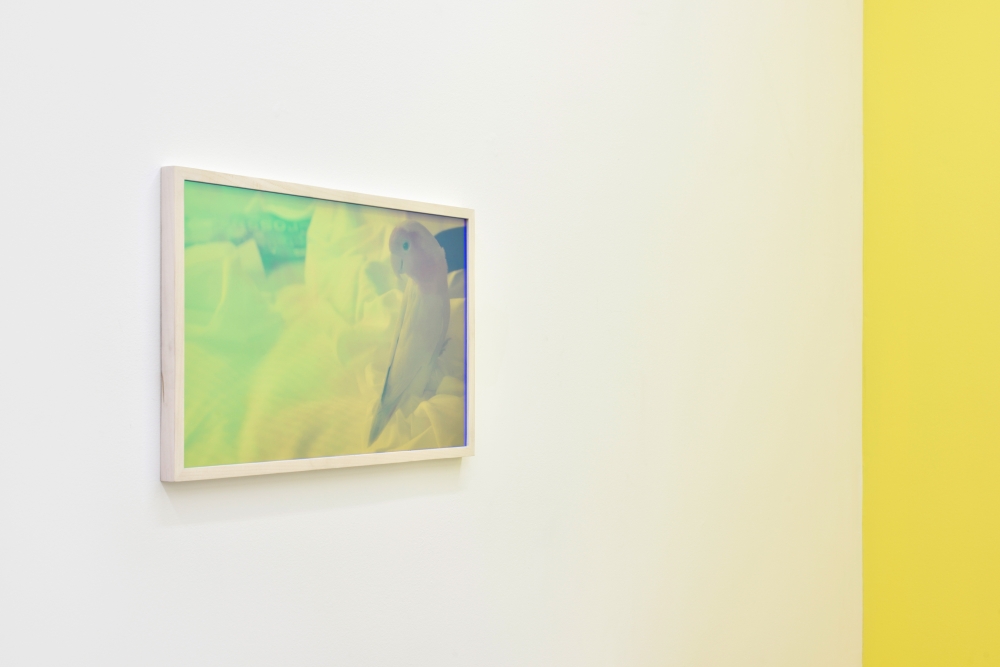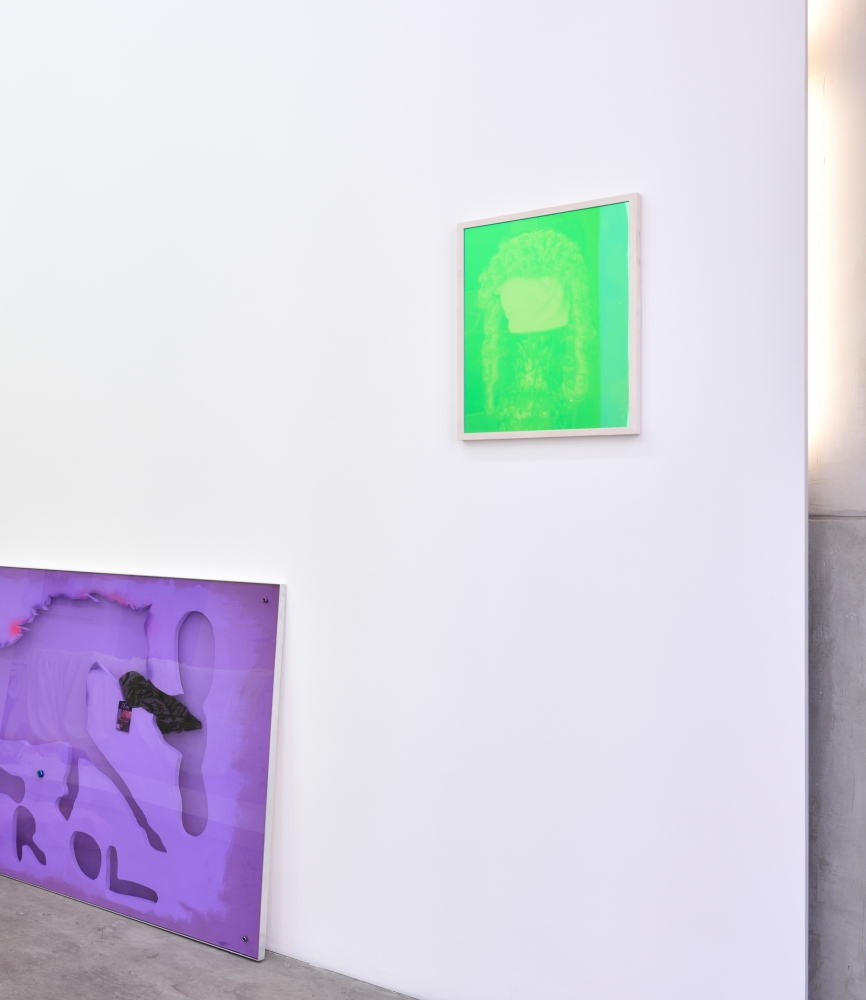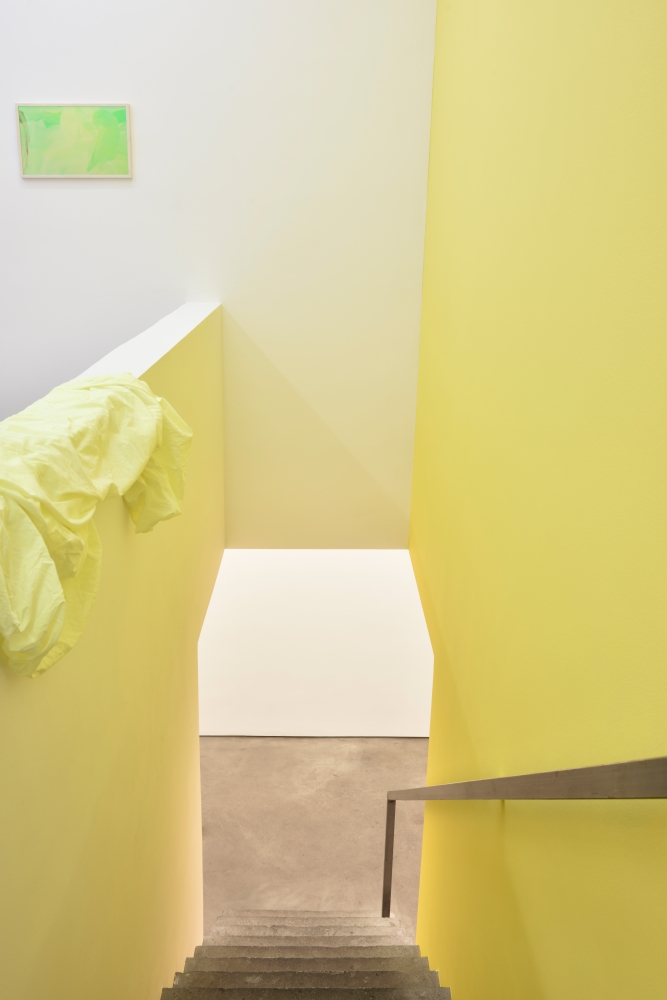“Yeah, that’s not an insult,” laughs Margaret Haines when I cautiously suggest that some of her interests are esoteric. For some reason I think it trivialises their existence – astrology, hieroglyphics, the life of artist, actor and occultist Cameron Parsons – but perhaps it has more to do with the stigma I’ve applied to the word that it doesn’t actually imply. “Maybe on some level but on other levels some stuff is not esoteric,” counters the Los Angeles and Amsterdam-based, Canadian artist behind the complicated exhibition with an elaborate name: The malignancy of Stupidity: the cutest evil (la coscienza sporca), le perroquet…Yesterday sounded too sentimental…once more: repression/negation/vulnerability…BOTH SHOWS SHOULD HAVE THE SAME TITLES…I like your note about friendship.

Ostensibly a solo show, The malignancy of Stupidity originally came in two parts, one featuring an installation and a film made by Haines and credited to many, and another a group exhibition that included the work of her friends Sands Murray Wassink, Anna Maria Pinaka, and Geo Wyeth. The latter component was organised in collaboration with curator Fabio Santacroce, who then enlisted a number of other artists to contribute, including Dan Bodan, Jesse Darling, Kareem Lotfy, and others. Both exhibitions ran concurrently at Paris’ Lily Robert from May 12 to June 17, while Haines’ installation, which includes a screening of ‘You face god and the camera at the same time,’ will stay up during the gallery’s Summer Show #2 till mid-July.
As if the distinction between the two shows wasn’t confusing enough, some of those artists featured in The malignancy of Stupidity (II) are also featured in the film of The malignancy of Stupidity (I). Murray Wassink can be seen vacuuming a Hilton hotel floor and reading from his own performance ‘All’s Not Well That Doesn’t End Well (Child-like Encouragement): An Open Letter To Kate Millett’ in the nude. Pinaka recites a manifesto while smoking on the balcony in a Thrasher magazine t-shirt. Wyeth’s tattooed arms appear, if only for a second. Titled ‘You face god and the camera at the same time,’ the film presents an intricate web of references and relationships that is emblematic of Haines’ profoundly literate practice-at-large.
Research-heavy and brimming with interrogations, she brings a dense network of names and events, histories and practices, into a remarkably well-defined aesthetic and approach to her art. There’s the subjective response to German philosopher Adorno’s Los Angeles horoscope analysis in the 2016 film ‘The Stars Down To Earth,’ then an adaptation of transgressive dramatist Jean Genet’s The Balcony in ‘You face god and the camera at the same time.’ A drop of Pasolini’s Salò appears in the script, as well as ripples of pioneer feminist Kate Millet and the occasional glimpse of Haines’ ongoing but unrelated research on the legendary Cameron Parsons. All of these ideas are given equal weight, breathlessly delivered in a thesis so multi-perspectival, so augmented that its logic almost teeters on the edge of incoherence. It’s a certain sense of refusal that also comes across in conversation with the artist, where sentences stop and start, ideas appear and dissolve, and resistance to authority lies in its evasion.

** When you’re talking about ‘You face god and the camera at the same time’ and these layers of people, it’s very dense. Is there a very specific logic within that, or are there loose ends?
MH: In terms of everyone who’s a performer being listed, and then also the references, I guess that’s the way to not – democratic isn’t necessarily the right word – but to not have a difference between Kate Millet, or the bird being considered evil in occult practices, or skate culture being taken over by the alt-right movement. All of those things I want on the same table, for them to be organised within the narrative that takes shape with the story, but also just existing as this film that the viewer can also interpret, or feel in a very sensual way.
Especially with this piece, it’s also a way to pay homage to a specific feminist discourse, like Kate Millet’s relationship to the white male literary canon. If you go to his website, [Sands] also is very specific, he has this one listing everyone he’s met, or that has influenced or inspired him, but specifically they’re artists and specifically it’s supposed to queer women or it’s within that, I don’t want to say lineage but dialogue or discussion.
** That makes total sense, in not paying homage but referencing influences, and therefore patterns of thought that you’re drawing from…
MH: Yeah, also because there’s a specific canon that you’re trying to fight against, or not necessarily fight but offer an alternative to. That’s not the full extent of Kate Millet’s project but that book was a way to insert herself into another canon. She was taking on Henry Miller and what had been consumed, or the status quo of what you should be digesting. So there’s a moment where, in the [‘Stars Down to Earth’] too, it was important to me to keep everyone on the same level. Like Adorno and, I don’t know, Susan Miller [laughs]. Maybe not Susan Miller necessarily because she’s not in the film but the people at the astrology class I was working with, to not have one idea be consumed or have a hierarchy of ideas somehow.
** Then the text you wrote to accompany ‘Stars Down to Earth,’ ‘Sex Without Threat,’ deconstructs this super masculine flow of capital, alongside astrology, giving them both equal weight in terms of importance or significance but then also bringing up this feminist element as a feminine-identified practice…

MH: Yeah, or at least with Adorno, it could have been replaced by coupons, and he did replace it with jazz, it was just a way for him to attack the culture industry of the US and authoritarian irrationalism. But at the same time that has an inherent flaw, which is, what is the system you’re presenting or the arbitrariness of that rationality or that line of thought? Rationality also has its own arbitrary space.
But also it’s weird because my friend Fiona Duncan who came with me to the astrology class a few times said, ‘yeah, it’s totally associated with the Goddess movement, it’s like a feminine practice’ but then the people who were studying with me in the class were financial analysts and they were mostly men. It’s also this thing, I feel like people have discussed this to death, but there’s this assumption where the alternative or ‘non-rational,’ ‘spooky’ movements are ‘girly’ but when you scratch the surface, it’s not really true. I don’t know how gendered it is but it may be perceived as gendered on one palatable level.
** It’s probably easier to do when thinking about a thing in retrospect, but do you think ‘The Stars Down to Earth’ revealed some necessary preconditions to what this video ‘You face god and the camera at the same time’ is covering?
MH: In some ways, [‘You face god and the camera at the same time’] is not only about Trump but I was considering Hilton equals Trump, or the idea that he’s replaceable somehow. The two films are not a series, one did not have to come before the other in any way but the Genet play The Balcony, from which the film ‘You face god and the camera at the same time’ is based, is the idea that the façade shifts, while the oligarchy stays in place. That could almost be considered the theme that is in ‘The Stars Down to Earth’ because you have this system that is in place but the news could be replaced with astrology forecasts, as much as explaining what’s happening in the White House. There’s this arbitrariness to information because there is already a power structure in place.
There’s that correlation, and then [‘You face god and the camera at the same time’] happens in a failed revolution society, maybe not an apocalyptic space, but the space of a failed revolution. There’s an energy to the ‘Stars Down to Earth’ that has this space of revolutionary change, or coming up, and The Balcony, or ‘You face god and the camera at the same time,’ could be interpreted as the epilogue or the aftermath to that revolution that has failed. But that’s kind of me going out on a limb a little bit. I don’t really consider them partnered.

** I’ve been thinking a lot about art practices that bring a specific ‘folk culture,’ for want of a better word, into an academic or artistic practice and then apply a certain language to it that is supposed to lift it upwards, in a way. It seems like that’s supposed to validate, or add value to it. I feel like that’s a weird thing to do because it’s not really addressing structural inequalities but picking something up and pulling it back into that existing structure. How do you come to terms with that when using these subjects within an art practice, which also has its own particular…
MH: …hegemony. That’s a good question. It’s difficult, I mean one tactic around ‘elevating’ the work – into a contemporary discourse so it seems hip, or to an intellectual discourse so it seems validated – is maybe to actually understand the material on a personal level somehow. That’s one tactic that a lot of ethnographers have used and I don’t want to turn to ethnography, because that seems like you’re bowing down, but in actually trying to live the work or not try to elevate it somehow.
** I understand that, in terms of subjectivising an experience of a thing or a culture, rather than applying an archetypal, objective voice.
MH: That’s what I mean but there are moments, even within that space or that tactic, where you can fall into the crevice of ethnography. The other thing that I go back to on that same plane in some ways is real friendship. I almost feel like the only time that this has really crept up in my work, is maybe with Cameron.
**A big issue I have is when an artist makes an anthropological work and then puts a disclaimer on it, as if that admonishes one of all responsibility.
MH: Yeah, of course, that attention has to somehow be in the fabric of the work. The thing is, all of the work that I’ve done with Cameron is writing so it’s an enjoyable space for me and it’s also coming from my own experience… to have two narratives happening at the same time somehow. It also has to be from my own experience and my own space as well. I can’t also be giving nothing, or not confessing something.
** It makes sense that you haven’t really included Cameron in any of your artwork, when you say that it’s a different approach. Why do you only apply this written approach to Cameron?
MH: The only work that I’ve done surrounding her has been writing and also my own research and then some of the research seeps into the work but it’s so far removed, you would really have to tease it out, like the hieroglyphic of the bird as a small evil [laughs]. But the way I came across Kate Millet is through Cynthia [Macadams] who was friends with Cameron and also there’s this written correspondence between Kate Millet and Cameron. But there are other things and Ana Maria Pinaka’s PhD thesis about ‘pornographing’ almost seems much more interesting in terms of that work, rather than the things that are circulating in my head as I’m also writing about Cameron.

**I was thinking when you were talking about the Thrasher t-shirt, that was something that I noticed watching ‘You face god…’ and there were a couple of other signals to this sort of contemporary art appropriation. You said before that you were referring to them after they had already been assimilated into that contemporary art context, so what are you doing with that Thrasher reference, is there some kind of meta-irony there or something?
MH: There are a few things. There is like a meta-irony, although that’s also not cool, [laughs] in many ways that is also happening in the film, where Anna Maria gives this manifesto on the balcony. She says, ‘politics is for now, art is forever,’ all these things that you hear in discourses against art as activism. It is kind of a removal so that manifesto is a space, or it is this meta-irony. But the Thrasher was a way to talk about – and I am still developing this language – this space of Independent Truck Company, or Shake Junt, or Thrasher, all of these skate symbols then being consumed by the alt-right. I know it’s a total conversation that I don’t really feel prepared to have but it was kind of a nod to that going on at the same time that that language was starting to bubble up, while I was making the film. There’s this absolution of these symbols that had been considered counterculture industry (but for so long we’ve know that they aren’t), using punk and skate culture, which is supposed to be anti-establishment, in this incredibly conservative discourse, and this terrorist conservative discourse. It was kind of like a footnote to that happening.
**I came across the headline the other day suggesting the alt-right is ‘weaponising irony.’

MH: I feel like that’s been going on for so long, like Vice magazine. I’m from Montréal where that magazine first grew, also with what’s happening now, it seems like all the stuff that is going on we already know, it seems so obvious and literal and for that reason it’s annoying that those tactics work. It’s annoying that Vice worked, the bros won, the fascist bro assholes won, and it was so easy and we all knew. Also, with Ana Maria wearing the t-shirt, what do you do with a troll? I keep coming back to this quote from Kenneth Anger, in terms of meta-irony, ‘you take it from them and you throw it back in their face,’ and it’s just like, what are the proper tactics to use when this person in front of you is just this flat ironic figure using terms like ‘ironic’… That’s one tactic, to be unanswerable or not interesting, or cool, or not cool at the same time. Completely deflecting all of the possible hashtags that you could be consumed into.**


























